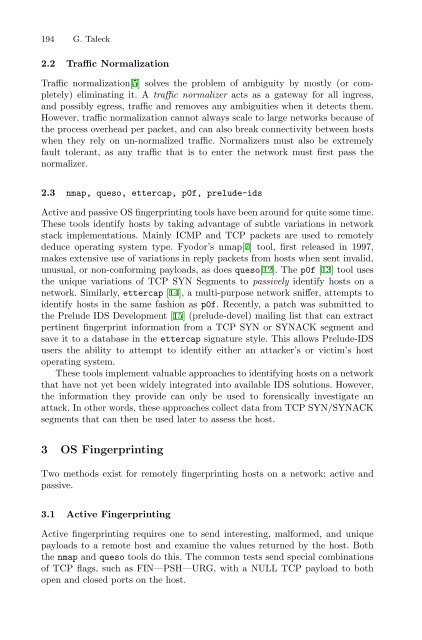LNCS 2820 - Ambiguity Resolution via Passive OS Fingerprinting
LNCS 2820 - Ambiguity Resolution via Passive OS Fingerprinting
LNCS 2820 - Ambiguity Resolution via Passive OS Fingerprinting
You also want an ePaper? Increase the reach of your titles
YUMPU automatically turns print PDFs into web optimized ePapers that Google loves.
194 G. Taleck<br />
2.2 Traffic Normalization<br />
Traffic normalization[5] solves the problem of ambiguity by mostly (or completely)<br />
eliminating it. A traffic normalizer acts as a gateway for all ingress,<br />
and possibly egress, traffic and removes any ambiguities when it detects them.<br />
However, traffic normalization cannot always scale to large networks because of<br />
the process overhead per packet, and can also break connectivity between hosts<br />
when they rely on un-normalized traffic. Normalizers must also be extremely<br />
fault tolerant, as any traffic that is to enter the network must first pass the<br />
normalizer.<br />
2.3 nmap, queso, ettercap, p0f, prelude-ids<br />
Active and passive <strong>OS</strong> fingerprinting tools have been around for quite some time.<br />
These tools identify hosts by taking advantage of subtle variations in network<br />
stack implementations. Mainly ICMP and TCP packets are used to remotely<br />
deduce operating system type. Fyodor’s nmap[7] tool, first released in 1997,<br />
makes extensive use of variations in reply packets from hosts when sent invalid,<br />
unusual, or non-conforming payloads, as does queso[12]. The p0f [13] tool uses<br />
the unique variations of TCP SYN Segments to passively identify hosts on a<br />
network. Similarly, ettercap [14], a multi-purpose network sniffer, attempts to<br />
identify hosts in the same fashion as p0f. Recently, a patch was submitted to<br />
the Prelude IDS Development [15] (prelude-devel) mailing list that can extract<br />
pertinent fingerprint information from a TCP SYN or SYNACK segment and<br />
save it to a database in the ettercap signature style. This allows Prelude-IDS<br />
users the ability to attempt to identify either an attacker’s or victim’s host<br />
operating system.<br />
These tools implement valuable approaches to identifying hosts on a network<br />
that have not yet been widely integrated into available IDS solutions. However,<br />
the information they provide can only be used to forensically investigate an<br />
attack. In other words, these approaches collect data from TCP SYN/SYNACK<br />
segments that can then be used later to assess the host.<br />
3 <strong>OS</strong> <strong>Fingerprinting</strong><br />
Two methods exist for remotely fingerprinting hosts on a network: active and<br />
passive.<br />
3.1 Active <strong>Fingerprinting</strong><br />
Active fingerprinting requires one to send interesting, malformed, and unique<br />
payloads to a remote host and examine the values returned by the host. Both<br />
the nmap and queso tools do this. The common tests send special combinations<br />
of TCP flags, such as FIN—PSH—URG, with a NULL TCP payload to both<br />
open and closed ports on the host.
















